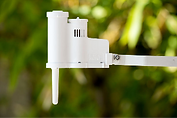


Sprinkler System Components








Pressure Vacuum Breaker or PVB is installed between the water source and the zone valves. It prevents the water in the piping in the sprinkler system from being siphoned back into the fresh water supply. The valves on the PVB will shutoff the water supply to the sprinkler system in the event a zone valve sticks open and cannot be turned off at the controller. During the winter season when hard freezes are possible the water is turned off and the PVB should be wrapped to insulate it to prevent freeze damage.
Master Shutoff Valve is located between the PVB and the water source. Although recommended not all sprinkler systems will have one installed. This valve will shutoff the water to the sprinkler system without having to turn off the water at the water meter in the event the PVB is freeze damaged and is leaking.
The Irrigation Control Valve is located in the ground in rectangular or round boxes. These valves when opened supply water to the sprinkler heads on a particular zone. They are controlled electrically from the controller.
Spray Nozzles are attached to pop up sprinkler heads that pop up from 4" to 12" above ground level. The spray nozzles can be a fixed pattern or adjustable to provide a spray arc from a few degrees to 360 degrees. The spray patterns can spray from 2 feet to 17 feet with specialty nozzles like side strip nozzles that spray 5 feet x 30 feet. Using the right nozzles with the right spray pattern it is possible to keep water off of hardscapes like concrete sidewalks, patios, driveways, and fencing and on your landscape where it belongs.
MP Rotator nozzles are attached to pop up sprinkler heads that pop up from 4" to 12" above ground level. These nozzles are adjustable to provide a spray arc from 90 degrees to 360 degrees. The spray patterns can spray from 8 feet to 35 feet with specialty nozzles like side strip nozzles that spray 5 feet x 30 feet. These nozzles like the spray nozzles can be used in both gardens and grass zones but are more efficient saving water.
Rotary sprinklers are used to cover large grass areas. They typically pop up 4" above ground level. They are adjustable to provide a spray arc from a few degrees to 360 degrees. The spray pattern can be from 20 feet up to 50 feet.
The Controller does just what its name implies. It controls the system. It controls the irrigation control valves turning on or turning off the sprinkler zones. The program controls zone start times, zone run times, and watering days. Newer controllers are wifi capable allowing you to set the programming up and manually controlling the system from a smart phone, tablet, or computer from anywhere. Some of these controllers also pull weather data from the internet and adjust watering run times accordingly for a more efficient system.
The Rain Sensor is a necessary component for any sprinkler system. It prevents the system from watering or turns off the system when it rains. The sensor can be wired or wireless. Wireless sensors have up to an 800 foot range allowing it to be mounted almost anywhere where the sensor is clear of any obstructions for it to catch the rain. A plus to the wireless sensor is you have no wires to worry about getting damaged disabling the system.